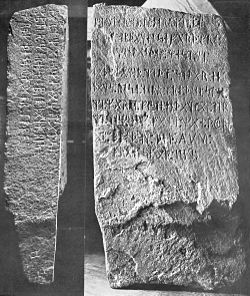Kensington Stone
| Kensington Runestone | |
|---|---|
 |
|
| Country | United States |
| Region | Minnesota |
| City/Village | Originally Kensington currently located at Alexandria, Minnesota |
| Produced | contested |
| Runemaster | contested |
|
Text – Native |
|
|
direct transliteration |
|
| Text – English | |
|
(word-for-word): |
|
| Other resources | |
|
Runestones – Runic alphabet Runology – Runestone styles |
|
direct transliteration
8 : göter : ok : 22 : norrmen : po :
...o : opþagelsefärd : fro :
vinland : of : vest : vi :
hade : läger : ved : 2 : skLär : en :
dags : rise : norr : fro : þeno : sten :
vi : var : ok : fiske : en : dagh : äptir :
vi : kom : hem : fan : 10 : man : röde :
af : blod : og : ded : AVM :
frälse : äf : illü.
här : (10) : mans : ve : havet : at : se :
äptir : vore : skip : 14 : dagh : rise :
(word-for-word):
Eight Götalanders and 22 Northmen on (this?) acquisition journey from Vinland far to the west. We had a camp by two (shelters?) one day's journey north from this stone. We were fishing one day. After we came home, found 10 men red from blood and dead. Ave Maria save from evil.
The Kensington Runestone is a 202-pound (92 kg) slab of greywacke covered in runes on its face and side. A Swedish immigrant, Olof Ohman, claimed to have discovered it in 1898 in the largely rural township of Solem, Douglas County, Minnesota, and named it after the nearest settlement, Kensington.
The inscription purports to be a record left behind by Scandinavian explorers in the 14th century (internally dated to the year 1362). There has been a drawn-out debate on the stone's authenticity, but the scholarly consensus has classified it as a 19th-century hoax since it was first examined in 1910, with some critics directly charging the purported discoverer Ohman with fabricating the inscription. Nonetheless, there remains a local community convinced of the stone's authenticity.
Swedish immigrant Olof Ohman asserted that he found the stone late in 1898 while clearing land he had recently acquired of trees and stumps before plowing. The stone was said to be near the crest of a small knoll rising above the wetlands, lying face down and tangled in the root system of a stunted poplar tree, estimated to be from less than 10 to about 40 years old. The artifact is about 30 × 16 × 6 inches (76 × 41 × 15 cm) in size and weighs 202 pounds (92 kg). Ohman's ten-year-old son, Edward Ohman, noticed some markings, and the farmer later said he thought they had found an "Indian almanac."
...
Wikipedia
